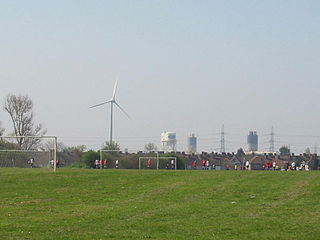
Becontree or is an area of approximately 4 square miles (10 km2) in the London borough of Barking and Dagenham. It is located 11 miles (17.7 km) east-northeast of Charing Cross and was constructed in the interwar period as the largest public housing estate in the world. The Housing Act 1919 permitted the London County Council to build housing outside the County of London and Becontree was constructed between 1921 and 1935 to cottage estate principles in the parishes of Barking, Dagenham and Ilford, then in Essex. The official completion of the estate was celebrated in 1935, by which time the estate had a population of around 100,000 people in 26,000 homes.

Dagenham is a town in East London, England, within the London Borough of Barking and Dagenham. It is centred 11.5 miles (18.5 km) east of Charing Cross, with Barking to the west, Romford and Hornchurch to the north-east, and Rainham to the south-east. Dagenham Dock, on the River Thames, is to the south.

Witham is a town in the county of Essex in the East of England, with a population of 25,353. It is part of the District of Braintree and is twinned with the town of Waldbröl, Germany. Witham stands between the city of Chelmsford and the town of Colchester, on the Roman road between the two. The River Brain runs through the town and joins the River Blackwater just outside.

Smethwick is an industrial town in Sandwell, West Midlands, England, historically in Staffordshire. It lies four miles west of Birmingham city centre, and borders West Bromwich and Oldbury to the north and west. Formerly a Staffordshire county borough, Smethwick is situated near the edge of Sandwell metropolitan borough and borders the Birmingham districts of Handsworth, Winson Green, Harborne, Edgbaston and Quinton to the south and east, as well as the Black Country towns of West Bromwich and Oldbury in the north and west.

Beckton is a suburban district in East London, England, within the London Borough of Newham and is located 8 miles (12.9 km) east of Charing Cross. Historically part of Essex, Beckton was unpopulated marshland adjacent to the River Thames until the development of major industrial infrastructure in the 19th century to support the growing metropolis of London. Housing was created in Beckton for workers of the gas and sewage works. Between 1981 and 1995 it was within the London Docklands Development Corporation area, which caused the population to increase as new homes were built and the Docklands Light Railway was constructed.

Ford of Britain is a British wholly owned subsidiary of Ford Technologies Limited, itself a subsidiary of Ford International Capital LLC, which is a subsidiary of Ford Motor Company. Its business started in 1909 and has its registered office in Laindon, Essex. It adopted the name of Ford of Britain in 1960.

Braintree Town Football Club is a semi-professional football club based in Braintree, Essex, England. They are currently members of the National League South, the sixth tier of English football, and play at Cressing Road.

Witham Town Football Club is a semi professional English football club based in Witham, Essex. The club are currently members of the Isthmian League North Division and play at Spa Road.

Valentine George Crittall, 1st Baron Braintree was a British politician and businessman who served briefly as a Labour Member of Parliament before later joining the Conservatives.
Rubery Owen is a British engineering company which was founded in 1884 in Darlaston, West Midlands.

Dagenham Dock is a place in the London Borough of Barking and Dagenham in London, England. It is located to the south of Dagenham and on the River Thames. It was once the site of a large coaling port and continues to be the location of a small terminal licensed to handle coal off-loading. Today the site is used for a number of river-related uses including a 25 acres (100,000 m2) TDG depot with around 200 tanks for storage of petrol, distillates, aviation fuel, biofuels, tallow, ethanol, fertilisers, urea etc.

Silver End is a village in Braintree, Essex, in England. It was conceived as a model village by the industrialist Francis Henry Crittall who established a Crittall Windows Ltd factory there to manufacture components for metal windows.

Victoria Road, currently known as the Chigwell Construction Stadium for sponsorship purposes, is the home ground of Dagenham & Redbridge F.C. of Dagenham, Greater London, England. It has a capacity of 6,078.

Chance Brothers and Company was a glassworks originally based in Spon Lane, Smethwick, West Midlands, in England. It was a leading glass manufacturer and a pioneer of British glassmaking technology.
The BCN Main Line, or Birmingham Canal Navigations Main Line describes the evolving route of the Birmingham Canal between Birmingham and Wolverhampton in England.

The Wednesbury Oak Loop, sometimes known as the Bradley Arm, is a canal in the West Midlands, England. It is part of the Birmingham Canal Navigations (BCN), and was originally part of James Brindley's main line, but became a loop when Thomas Telford's improvements of the 1830s bypassed it by the construction of the Coseley Tunnel. The south-eastern end of the loop was closed and in parts built over, following the designation of the entire loop as "abandoned" in 1954, including the section which was filled in at the beginning of the 1960s to make way for the Glebefields Estate in Tipton.
Cressing Road is a football stadium in Braintree, Essex, and the home ground of Braintree Town, and formally their reserve side. It currently has a capacity of 4,151.
Crittall Windows Ltd is a notable English manufacturer of steel-framed windows, today based in Witham, Essex, close to its historic roots in the county. Its products have been used in thousands of buildings across the United Kingdom, including the Houses of Parliament and Tower of London, and are features particularly associated with the Art Deco and Modernist movements in early 20th-century architecture.
Francis Henry Crittall (1860–1935) was an English businessman and philanthropist who in 1884 in the Essex town of Braintree instigated the manufacture of metal-framed windows by the Crittall Manufacturing Company Ltd. This company, now known as Crittall Windows Ltd, became the world's leading manufacturer of steel-framed windows. Crittall also funded the development of the model village of Silver End in Essex.

Meadows Frisky is the name of a series of small British cars manufactured at the factory of Henry Meadows Ltd at Fallings Park in Wolverhampton between 1958 and 1961, during which time, production was under the control of a number of companies.















